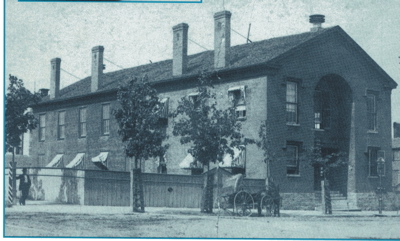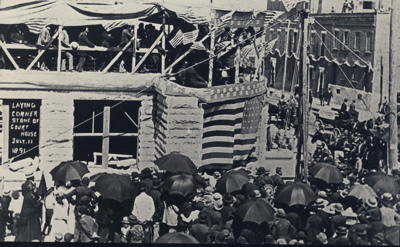Encyclopedia Dubuque
"Encyclopedia Dubuque is the online authority for all things Dubuque, written by the people who know the city best.”
Marshall Cohen—researcher and producer, CNN
Affiliated with the Local History Network of the State Historical Society of Iowa, and the Iowa Museum Association.
DUBUQUE COUNTY COURTHOUSE
DUBUQUE COUNTY COURTHOUSE. The first building for public meetings and the administration of justice was a log structure in what became WASHINGTON PARK. In 1833 the building was constructed by the Methodists as a church, but during the week it found use as a school and courthouse. The first District Court of Iowa convened in this building in 1837. (1)
Edward LANGWORTHY donated land to the county for the site of a courthouse at Seventh and Clay (now Central). The second county courthouse (pictured) was a massive brick structure built from 1839-1841 by a John Sullivan and an Amos Mathews who plastered it. (2) Samuel Wilkings and Joseph Ogilby were both credited with being the architect. An estimated 244,518 bricks for the construction came from the Langworthy brickyards. An addition to the west was constructed in 1856 from a design made by John Francis RAGUE. (3)
With the growth in population, citizens began discussing the construction of a new courthouse. The current courthouse was surrounded by commercial development. When Dubuque was platted by an act of Congress on July 3, 1836 the United States reserved from sale the land on which the first courthouse had stood. Residents near the park, however, protested the construction plans and nothing was done. (4)
Senator Allison introduced a bill in Congress in 1876 giving Washington Square to the county for courthouse purposes. Many here opposed this bill, because the county could afford to buy it. (5) Many suggestions were made for the site of the new building. There was consideration for placing it in JACKSON PARK because the location was near "the center of population." Those with a view to the future made the case for building the courthouse along 18th street "as it would be near the center of population fifteen or twenty years hence." (6)
Deteriorating conditions in the courthouse led the Board of Supervisors in 1890 to launch a campaign for a new building. A citizens' petition had failed in 1878. In 1890 with Peter KLAUER presiding, a committee adopted a resolution on April 22nd stating
Resolved, That it is the sense of this committee that there be
submitted to a vote at a special election, the question, "Shall
shall the county issue $125,000 twenty-five year four percent
bonds for the purpose of building a courthouse? with the under-
standing that such a courthouse shall be built on the present
site or on such other suitable site as the city or the citizens
of the city of Dubuque may donate to the county for that purpose.
The date of the special election was to be selected by the board of supervisors "after the planting season and at a date which will be most convenient to the farmers." (7)
Controversy arose where the building should be constructed. JACKSON PARK was mentioned, but an ordinance of 1861 stated that the site was "reserved, dedicated and established as a public square to be known as Jackson Square forever...as a place of public resort and recreation. (8)
In 1891 the building was sold at public auction and then demolished for the construction of the present building.
The present Courthouse, Dubuque's best example of BEAUX ARTS ARCHITECTURE, was designed by Fridolin HEER and Son. It is constructed of gray Indiana limestone, brick and molded terra cotta. One of the first local buildings added to the NATIONAL REGISTER OF HISTORIC PLACES, the Courthouse is eighty-eight by one hundred twenty-five feet in size. (9) A central tower rising one hundred ninety feet is capped with a fourteen-foot tall bronze statue of Justice. Allegorical pewter figures remain on the building. (10)
During WORLD WAR I, four large statues of winged angels with trumpets were removed and melted down to aid in the war effort. A glass dome on the fourth floor was removed when the elevator was installed. (11)
The Dubuque Cultural Commission in 1962 endorsed a project that would improve the appearance of the courthouse dome. Suggesting that work begin in 1963, the Commission suggested that the dome be painted and lighted "because the courthouse is the tallest building in Dubuque and a low-flying airplane could hit it." Lighting would also make the dome and the statue of Justice stand out. (12)
In 1965 the GRUEN REPORT recommended that the courthouse be demolished with a proposed freeway being constructed over the site. In 1970 the freeway was still under consideration with consideration being made to run the roadway between the courthouse and the Kirby Building. Interest in keeping the 78-year old building had increased with URBAN RENEWAL and the demolition of many of the city's rundown buildings giving residents a better view of the historic building. (13)
On July 23, 1970 the Chicago engineering firm of C. F. Murphy and Associates presented a $2 million program to renovate the courthouse. Among the changes proposed was the removal of the large flight of stairs on Central Avenue and those inside from first to third floors. The large interior steps would be replaced by smaller flights throughout the building. An elevator would serve all floors. (14)
Renovation of the building in the 1980s included a ground floor entrance to replace the second floor entrance on Central Avenue. A controversial gold leaf coating on the dome was added in 1983. Private support for the $74,500 project included a $10,000 donation from the Marcella Lott Trust Fund. Much of the remaining money came from federal revenue sharing. (15) Interior work included the addition of a granite fountain, a reminder of the original watering troughs for horses that stood outside. Plaster was removed from the walls to reveal the original brick and a five-story glass-encased elevator was added. (16) The desire of the residents to maintain the building was shown by a rejection of a bond issue to add an annex and the public outcry when the Department of Transportation proposed demolishing the building for a new freeway. (17)
In fiscal 1993-1994 nearly $830,000 was planned for improvements in the courthouse. Of the total, about half would be spent on preserving the tower. The railings needed repair and the eaves and railings needed painting. While the scaffolding was in place, efforts were considered to polish the 23-karat gold leaf. At the suggestion of architects, soap and water will be used to clean the dome. The additional money would be: $81,000 to pave the parking lot, $30,000 for new carpet, $23,500 for repairing the fourth floor porch, and $15,000 to remodel judges' chambers. (18)
Among the most memorable incidents at the courthouse was the time its exterior was climbed by Everett AKINS.
---
Source:
1. Oldt, Franklin T. History of Dubuque County, Iowa. http://www.ebooksread.com/authors-eng/franklin-t-oldt/history-of-dubuque-county-iowa-being-a-general-survey-of-dubuque-county-histor-tdl/page-20-history-of-dubuque-county-iowa-being-a-general-survey-of-dubuque-county-histor-tdl.shtml
2. "Back When," October 3, 1962, p. 28
3. Oldt.
4. Ibid.
5. Ibid.
6. "Caught on the Fly," Dubuque Herald, January 20, 1876, p. 4. Online: https://news.google.com/newspapers?nid=uh8FjILnQOkC&dat=18760120&printsec=frontpage&hl=en
7. "The New Court House," Dubuque Daily Herald, April 23, 1890, p. 4
8. Oldt.
9. "The Court House Location," Dubuque Herald, June 17, 1890
10. Kruse, Len. "The County Courthouse," My Old Dubuque, Center for Dubuque History, Loras College, p. 42-44
11. Ibid.
12. "Courthouse Dome Work is Endorsed," Telegraph Herald, September 19, 1962, p. 1
13. Bulkley, John. "Freeway Planning Tied to Courthouse Decision," Telegraph Herald, July 22, 1970
14. Walters, Steve. "Courthouse Fix-Up Cost: $2 Million," Telegraph Herald, July 24, 1970, p. 1
15. Dickel, Dean. "Renovations Costly on 'This Old Courthouse,'" Telegraph Herald, May 12, 1994, p. 3
16. Kruse.
17. Dickel
18. Japsen, Bruce. "County Plans Courthouse Improvements," Telegraph Herald, February 5, 1993, p. 3A







